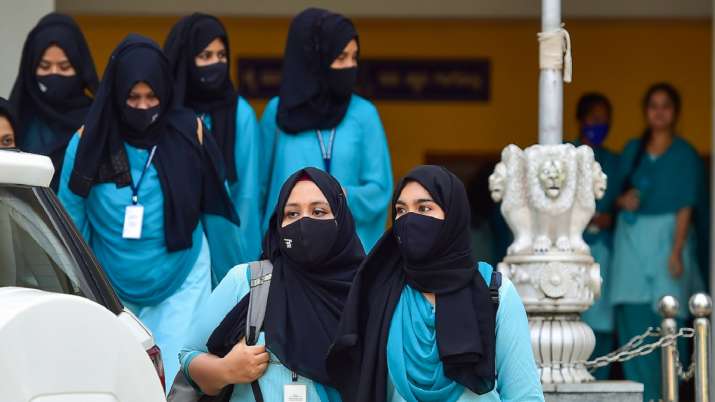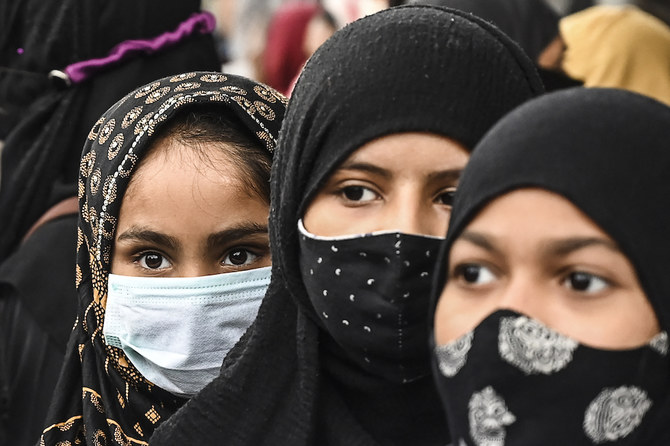The Karnataka High Court’s 129-page ruling puts the fundamental religious practise test at the centre of the hijab dispute, dismissing petitioners’ claims on the right to freedom of speech and expression and the right to equality as “derived rights” that are “lesser rights.”

Lack of examination of the Karnataka government’s directive permitting universities to prohibit wearing a hijab; separation of freedom of conscience from religious freedom: these are the primary grounds on which the Karnataka High Court ruling on the hijab ban is likely to be challenged before the highest court.
The 129-page ruling, which supports the state’s position, puts the basic religious practise test at the centre of the discussion over hijab, dismissing petitioners’ claims about the right to freedom of speech and expression and the right to equality as “derived rights” that are “lesser rights.”
Indeed, the bench emphasises “restrictions” strengthening the government’s position throughout rather than interpreting “freedoms” mentioned by the petitioners.
“The petitions we’re dealing with don’t concern the right to freedom of speech and expression, or the right to privacy, to the degree that these procedures for evaluating contended limits, such as a school dress code, should be used,” the bench stated.
The petitioners’ “complaint is against the breach of fundamentally derivative rights,” rather than “the core of substantive rights,” it claimed. The court then utilised this argument to argue that the protection afforded to “substantive rights” can’t be “extended too far even to include derivative rights of this sort.”
That’s not all, though. The court likened children in schools, which it referred to as “qualified public places,” to captives in jail who are unable to exercise their basic rights individually.
“It is scarcely necessary to clarify that schools are ‘qualified public spaces’ designed primarily for the purpose of giving educational instructions to students…
“By their very nature, such ‘qualifying areas’ resist the assertion of individual rights to the detriment of their overall discipline and decorum,” the court stated.
The petitioners also raised a number of other issues, including direct and indirect discrimination against Muslim women as a result of a Karnataka government order issued under the Karnataka Education Act, 1983, which cited public order, unity, and integrity of the country as justifications for prohibiting Muslim women from wearing the hijab.
However, the court dismissed this claim. “By no stretch of the imagination, it can be maintained that imposing a clothing code infringes on students’ basic right to speech or autonomy.” When the clothing code is equally applied to all students, regardless of religion, language, gender, or other factors, there is no basis for a complaint of obvious arbitrariness or discrimination under Articles 14 and 15. Nobody can claim that the clothing code is sectarian,” it stated.
The government order was detached from the petitioner’s claim against the uniform during the court’s analysis of the discrimination argument. The court first found that a uniform is not inherently discriminatory, and that the government directive “per se does not prescribe any uniform but simply provides for prescription in a structured manner.”
While public order is one of the reasons for restricting religious freedom under the Constitution, the state administration said the restriction was due to a drafting error in the text. Despite the government’s admission, the Court did not consider the order’s merits and granted the state the benefit of the doubt.
“We hasten to stress that some expressions used in a Government Order, such as ‘public order,’ etc., are not to be read in the same way that they are in the Constitution or Statutes.” The linguistic architecture of legislation and promulgating a statutory order like the one at hand are vastly different. The former’s draughtsmen are credited for “due attention and seriousness in the use of terms that government employees sometimes lack when textually framing legislative policy,” according to the court.
On the issue of religious freedom, the petitioners claimed that wearing the hijab is a separate right from religious freedom. The court, on the other hand, stated that simply stating their conscience would not be sufficient, and that the petitioners would have to present proof to back up their claims.
“There is no indication that the petitioners opted to wear their headscarves to communicate any thinking or religion or as a form of symbolic expression.” “To say the least, pleadings for advocating the basis of conscience are cursory,” the court ruled.











